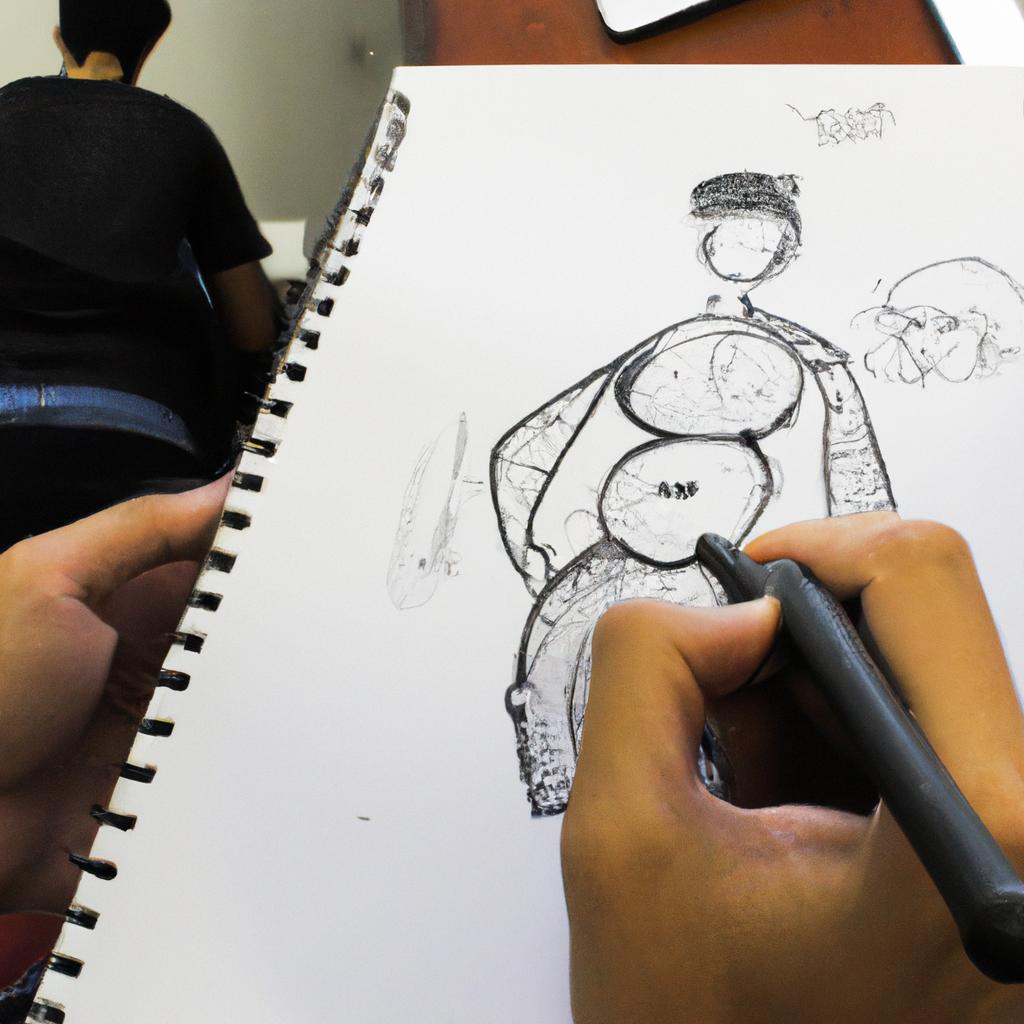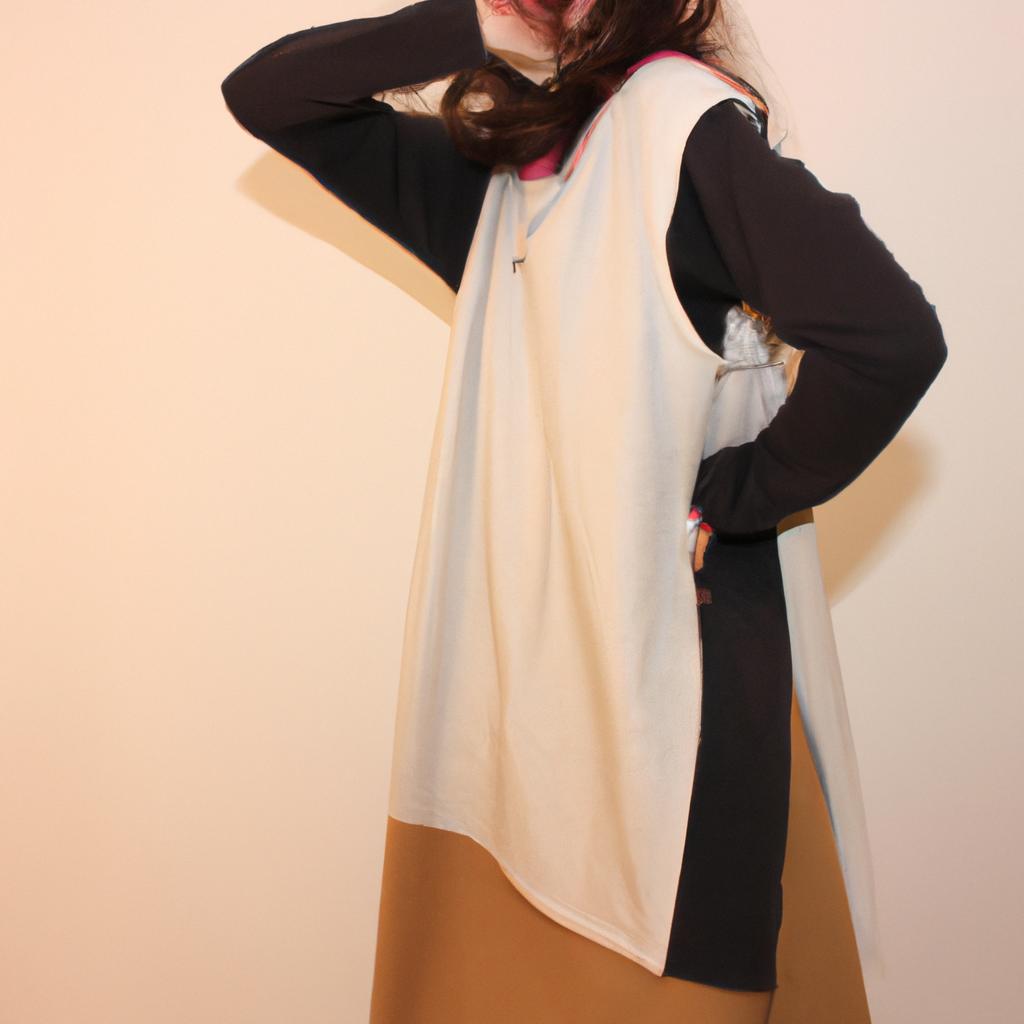Backstory and personality traits are essential components of character design in arts and illustration. They provide depth, complexity, and relatability to the characters portrayed, allowing audiences to engage with them on a more profound level. By delving into their past experiences, motivations, and unique qualities, artists can create compelling narratives that resonate with viewers.
For instance, consider the case of a fictional character named Emily. Through careful consideration of her backstory and personality traits, an artist can develop her as a multidimensional individual. Perhaps Emily grew up in a small coastal town where she developed a fascination for marine life due to her father’s profession as a fisherman. This experience shaped her curious nature and love for adventure. Additionally, Emily possesses strong empathy towards others after witnessing the struggles faced by local fishermen during rough times at sea. These aspects of her backstory inform her personality traits – courageousness, curiosity, and compassion – which add richness to her portrayal.
In this article, we will explore how backstory and personality traits contribute to effective character design in arts and illustration. We will examine various techniques used by artists to craft believable backstories and personalities for their characters, including research methods such as studying historical contexts or conducting interviews with individuals who share similar experiences. Furthermore, we will also discuss the importance of consistency and coherence within a character’s backstory and personality traits. Artists must ensure that these elements align with the overall narrative or theme of their artwork to create a seamless and engaging portrayal.
Moreover, we will delve into the significance of relatability in character design. By infusing relatable qualities and experiences into a character’s backstory and personality traits, artists can establish a connection between the audience and the character. This connection fosters empathy, allowing viewers to invest emotionally in the story being told.
Additionally, we will explore how artists can use symbolism and visual cues to enhance their characters’ backstories and personalities. Symbolism can add depth to a character’s journey by representing abstract concepts or emotions visually. Visual cues, such as costume choices or body language, can provide subtle hints about a character’s past experiences or current state of mind.
Throughout this article, we will provide examples from various art forms and discuss how different artists have effectively incorporated backstory and personality traits into their character designs. By understanding the importance of these components, artists can create compelling characters that captivate audiences and leave a lasting impression.
The significance of backstory in character development
The Significance of Backstory in Character Development
When it comes to character development in arts and illustration, the backstory plays a crucial role in shaping the overall narrative and creating relatable characters. By providing insight into a character’s past experiences, motivations, and personal history, the backstory adds depth and complexity to their persona. To illustrate this point, let us consider the fictional character of Emily, an aspiring artist who grew up in a small town with limited exposure to art.
One significant aspect of incorporating backstories is that they allow for better audience engagement through emotional connection. When readers or viewers are presented with a well-developed backstory, they can relate more easily to the character’s struggles, triumphs, and aspirations. This emotional resonance fosters empathy between the audience and the character, making them feel invested in their journey. For instance:
- Emily’s childhood dream was fueled by her grandmother’s unwavering support.
- Despite facing financial constraints growing up, she persevered by participating in local art contests.
- The loss of her father at a young age became a driving force behind her determination to succeed as an artist.
- A chance encounter with a renowned painter during college inspired her to pursue her passion even further.
To highlight the significance of backstories further, we can examine how they contribute to visual storytelling using a table format:
| Aspect | Effect on Storytelling |
|---|---|
| Emotional | Elicits empathy |
| Psychological | Provides context |
| Motivational | Influences behaviors |
| Relatability | Enhances connections |
By carefully constructing compelling backstories for characters like Emily, artists have the opportunity to immerse audiences in intricate narratives filled with vivid emotions. Exploring these multifaceted backgrounds allows artists to connect with their viewers on a deeper level and create meaningful artistic experiences.
Transitioning into the subsequent section about “Exploring the impact of personality traits on character design,” it is essential to understand how a character’s backstory intertwines with their unique personality. This examination will further enhance the depth and authenticity of artistic creations by considering the interplay between narrative and individual traits.
Exploring the impact of personality traits on character design
In character design, personality traits play a crucial role in shaping the overall appearance and behavior of fictional individuals. By providing distinct qualities to characters, artists and illustrators can create more relatable and dynamic figures that resonate with audiences. For instance, let’s consider a hypothetical example of a character named Sophie – an introverted bookworm who possesses a deep love for knowledge.
The impact of personality traits on character design can be observed through various aspects:
-
Physical Appearance: A character’s personality traits often influence their physical features. In Sophie’s case, her introversion may be reflected in subtle details like her posture, expressions, or even the way she holds books close to her chest. These visual cues help viewers form immediate impressions about her nature without explicitly stating it.
-
Clothing Choices: Personality traits also guide the selection of clothing for a character. Sophie’s reserved nature might translate into modest attire, avoiding flashy colors or attention-seeking garments. Her preference for comfort over trendiness may be seen in loose-fitting clothes that allow freedom of movement while engrossed in reading.
-
Poses and Gestures: The body language adopted by characters is another powerful tool for conveying personality traits. Sophie could be depicted hunched over a book, lost in thought, emphasizing her introspective nature. Such poses contribute to creating a strong sense of realism and connection between the audience and the character.
-
Facial Expressions: Characters’ facial expressions are key indicators of their personalities as well. Sophie’s furrowed brows and intense focus while reading reveal her intellectual curiosity and dedication towards learning—a trait central to her persona.
To further explore these ideas, we can refer to the following table showcasing different examples of how specific personality traits manifest visually:
| Personality Trait | Visual Manifestation |
|---|---|
| Confidence | Upright posture |
| Playfulness | Wide, cheerful smile |
| Shyness | Downcast eyes |
| Determination | Firmly clenched fists |
By incorporating personality traits into character design through these visual elements, artists can elicit emotional responses from viewers. The ability to relate to a character’s demeanor and appearance helps establish a deeper connection, enhancing the overall storytelling experience.
Transitioning seamlessly into the subsequent section about finding inspiration from real-life individuals for creating unique characters, we delve further into the process of deriving characteristics that make fictional figures more authentic and relatable.
Finding inspiration from real-life individuals for creating unique characters
Personality traits play a significant role in character design, as they contribute to the overall depth and relatability of a fictional persona. By infusing these traits into their creations, artists and illustrators can bring characters to life and establish a connection with their audience. For instance, let’s consider the case of Sarah, an artist known for her vibrant illustrations. She decides to create a new character named Maya, who possesses distinct personality traits that influence her appearance and behavior.
To better understand this relationship between personality traits and character design, we can identify several key points:
- Emotional range: Characters with diverse emotional expressions tend to resonate more deeply with audiences. Incorporating different emotions such as joy, sadness, anger, or fear allows viewers to relate to the characters’ experiences.
- Contrasting characteristics: Introducing contrasting personality traits within a single character adds complexity and intrigue. Pairing qualities like kindness and stubbornness or intelligence and impulsiveness creates multidimensional characters that feel authentic.
- Alignment with story arc: The personality traits assigned to a character must align with their role in the narrative. For example, if a protagonist undergoes growth throughout the story, their initial temperament may be purposefully flawed or conflicted.
- Symbolic representation: Certain personality traits can act as symbolic representations of broader themes or ideas within a work of art or illustration. This symbolism adds layers of meaning while allowing viewers to interpret characters from various perspectives.
By incorporating these factors into their designs, artists and illustrators can evoke specific emotional responses from their audience while crafting compelling narratives through visual storytelling techniques.
The next section will delve into how real-life individuals serve as inspiration for creating unique characters by examining how culture and environment shape personalities without relying solely on personal anecdotes or subjective opinions.
The role of culture and environment in shaping character personalities
Building upon the concept of finding inspiration from real-life individuals, understanding how culture and environment shape character personalities is crucial in creating compelling and relatable characters. By examining these factors, artists and illustrators can add depth to their creations, making them more engaging for viewers.
One example that highlights the role of culture and environment in shaping character personalities is the case study of two twins raised under different circumstances. Twin A grew up in a bustling city, surrounded by diverse cultures and experiences, while Twin B was raised in a remote countryside village with limited exposure to external influences. Despite sharing the same genetic makeup, their distinct environments led to vastly different personality traits. Twin A developed an outgoing and adventurous nature due to constant exposure to new ideas and interactions, whereas Twin B became more introverted and contemplative as a result of living a quieter life.
To further explore this topic, several key points can be considered:
- Cultural norms: Different societies have unique expectations regarding behavior, values, and beliefs. These cultural norms heavily influence how individuals develop their personalities.
- Socioeconomic status: The economic conditions one grows up in can impact access to education, opportunities for personal growth, and overall worldview.
- Family dynamics: The family unit plays a significant role in shaping an individual’s personality. Factors such as parenting style, sibling relationships, and familial traditions all contribute to character development.
- Historical context: Understanding historical events within a specific timeframe helps contextualize character motivations and reactions to certain situations.
| Cultural Norms | Socioeconomic Status | Family Dynamics | Historical Context |
|---|---|---|---|
| Shapes behaviors | Impacts opportunities | Influences perspectives | Provides backdrop |
In conclusion,
by considering the influence of culture and environment on character personalities,
artists and illustrators can create more realistic and multi-dimensional characters.
This adds depth to their work,
making it easier for viewers to connect with and emotionally invest in the characters.
Balancing visual aesthetics with conveying a character’s personality, artists must carefully select design elements that effectively communicate the intended traits.
Balancing visual aesthetics with conveying a character’s personality
Transitioning from the previous section that highlighted the role of culture and environment in shaping character personalities, it is essential to delve into how these factors contribute to the process of character design in arts and illustration. To illustrate this point, let us consider a hypothetical case study: designing a protagonist for a fantasy novel set in a dystopian future.
One aspect that artists must take into account when creating characters is their backstory. In our case study, imagine the protagonist grew up in an oppressive society, constantly battling against injustice. This upbringing will shape their personality traits, such as resilience, determination, and perhaps even hints of rebellion against authority figures. By incorporating these elements into the character’s visual representation, illustrators can effectively convey their backstory and enhance audience engagement.
When translating a character’s backstory and personality traits into visuals, certain techniques can evoke emotional responses from viewers:
- Color palette selection: Utilizing dark hues or muted tones can reflect a somber past or emphasize the struggles faced by the character.
- Body language and facial expressions: Conveying tension through clenched fists or furrowed brows can communicate inner turmoil or defiance against adversity.
- Symbolism: Incorporating symbolic elements like scars or worn-out clothing can serve as visual cues representing pivotal moments in the character’s life.
- Composition choices: Placing the character off-center within an image can create a sense of imbalance, mirroring their internal conflicts and challenges.
To further exemplify these concepts, refer to the following table showcasing various fictional characters’ backstories and corresponding design choices:
| Character | Backstory | Visual Representation |
|---|---|---|
| Alice | Orphaned after losing her family | Wearing tattered clothes with tear-streaked cheeks |
| Max | Grew up in poverty-stricken neighborhoods | Sporting weathered sneakers and a determined gaze |
| Luna | Survived a traumatic event | Adorned with visible scars and haunted eyes |
| Sophia | Raised in an affluent, sheltered environment | Clad in elegant attire, exuding confidence |
In summary, the backstory and personality traits of characters play a pivotal role in their visual design. By considering these aspects during the artistic process, illustrators can effectively convey depth and engage viewers on an emotional level.
Understanding how backstory and personality influence character design leads us to explore tips and techniques for effectively portraying these elements in illustrations.
Tips and techniques for effectively portraying backstory and traits in illustrations
Balancing visual aesthetics with conveying a character’s personality is crucial in character design for arts and illustration. It requires careful consideration of various elements to effectively portray the backstory and traits of a character. By utilizing specific techniques, artists can create visually appealing illustrations that also capture the essence of their characters.
To understand how this balance works, let’s consider an example: imagine a fantasy world where a young princess named Aurora possesses both strength and vulnerability. To convey her personality through art, an artist could employ several strategies:
-
Color palette selection: The choice of colors plays a significant role in evoking emotions and reflecting the character’s traits. For instance, using warm tones like gold and pink may symbolize Aurora’s warmth and compassion, while incorporating cool hues such as blue or purple can represent her mysterious side.
-
Body language and facial expressions: How the character carries themselves physically speaks volumes about their personality. In Aurora’s case, subtle body gestures like closed-off postures mixed with gentle smiles could signify her guarded nature combined with a compassionate heart.
-
Symbolism and motifs: Incorporating symbolic elements into the artwork deepens the understanding of a character’s backstory. In this scenario, including imagery associated with crowns or flowers might hint at Aurora’s royal lineage or connection to nature.
-
Composition choices: The arrangement of elements within an illustration helps emphasize certain aspects of a character’s story. Placing Aurora against a backdrop featuring towering mountains could suggest her resilience amidst challenging circumstances.
By skillfully employing these techniques (as well as others relevant to specific artistic styles), illustrators can successfully depict not only the external appearance but also the inner depth of their characters.
To further illustrate these concepts, we can examine some key tips and techniques commonly used by artists when portraying backstory and traits in illustrations:
- Emphasize contrasting elements: Highlighting opposing characteristics within one image creates intrigue and complexity.
- Utilize symbolism: Symbolic imagery can provide subtle hints about a character’s history and personality traits.
- Pay attention to details: Incorporating small, intricate elements adds depth and richness to the overall composition.
- Experiment with different styles: Exploring diverse artistic approaches allows for unique interpretations of characters’ backstories and personalities.
In summary, achieving an effective balance between visual aesthetics and conveying a character’s backstory and traits is essential in character design for arts and illustration. By employing techniques such as color palette selection, body language, symbolism, and careful composition choices, artists can create captivating illustrations that go beyond surface-level visuals. These strategies engage viewers emotionally by offering glimpses into the complex inner worlds of fictional characters.
 PSP Oste
PSP Oste



